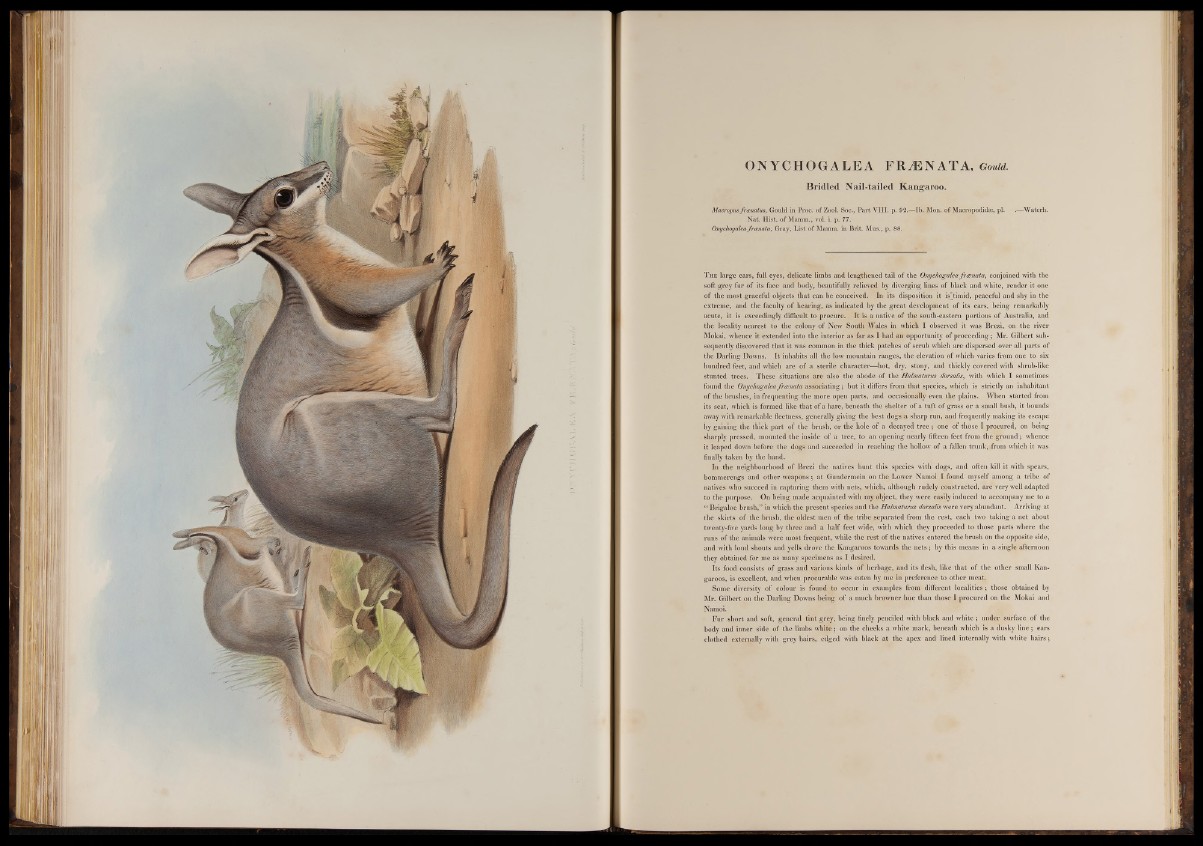
Hy
ONYCHOGALEA FRANATA, Gould.
Bridled Nail-tailed Kangaroo.
Macropus freenatus, Gould in Proc. of Zool. Soc., Part V III. p. 92.—lb. Mon. of Macropodidse, pi. .—Waterh.
Nat. Hist, of Mamm., vol. i. p. 77.
Onychogalea/remata, Gray, List of Mamm. in Brit. Mus., p. 88.
T he large ears, full eyes, delicate limbs and lengthened tail of the Onychogalea frcenata, conjoined with the
soft grey fur of its face and body, beautifully relieved by diverging lines of black and white, render it one
of the most graceful objects that can be conceived. In its disposition it is’timid, peaceful and shy in the
extreme, and the faculty of hearing, as indicated by the great development of its ears, being remarkably
acute, it is exceedingly difficult to procure. It is a native of the south-eastern portions of Australia, and
the locality nearest to the colony of New South Wales in which I observed it was Brezi, on the river
Mokai, whence it extended into the interior as far as I had an opportunity of proceeding; Mr. Gilbert subsequently
discovered that it was common in the thick patches of scrub which are dispersed over all parts of
the Darling Downs. It inhabits all the low mountain ranges, the elevation of which varies from one to six
hundred feet, and which are of a sterile character—hot, dry, stony, and thickly covered with shrub-like
stunted trees. These situations are also the abode of the Halmaturus dorsalis, with which I sometimes
found the Onychogalea frcenata associating; but it differs from that species, which is strictly an inhabitant
of the brushes, in frequenting the more open parts, and occasionally even the plains. When started from
its seat, which is formed like that of a hare, beneath the shelter of a tuft of grass or a small bush, it bounds
away with remarkable fleetness, generally giving the best dogs a sharp run, and frequently making its escape
by gaining the thick part of the brush, or the hole of a decayed tre e ; one of those I procured, on being
sharply pressed, mounted the inside of a tree, to an opening nearly fifteen feet from the ground; whence
it leaped down before the dogs and succeeded in reaching the hollow of a fallen trunk, from which it was
finally taken by the hand.
In the neighbourhood of Brezi the natives hunt this species with dogs, and often kill it with spears,
bommerengs and other weapons; at Gundermein on the Lower Namoi I found myself among a tribe of
natives who succeed in capturing them with nets, which, although rudely constructed, are very well adapted
to the purpose. On being made acquainted with my object, they were easily induced to accompany me to a
“ Brigaloe brush,” in which the present species and the Halmaturus dorsalis were very abundant. Arriving at
the skirts of the brush, the oldest men of the tribe separated from the rest, each two taking a net about
twenty-five yards long by three and a half feet wide, with which they proceeded to those parts where the
runs of the animals were most frequent, while the rest of the natives entered the brush on the opposite side,
and with loud shouts and yells drove the Kangaroos towards the nets; by this means in a single afternoon
they obtained for me as many specimens as I desired.
Its food consists of grass and various kinds of herbage, and its flesh, like that of the other small Kangaroos,
is excellent, and when procurable was eaten by me in preference to other meat.
Some diversity of colour is found to occur in examples from different localities; those obtained by
Mr. Gilbert on the Darling Downs being of a much browner hue than those I procured on the Mokai and
Namoi.
Fur short and soft, general tint grey, being finely penciled with black and white ; under surface of the
body and inner side of the limbs white; on the cheeks a white mark, beneath which is a dusky line; ears
clothed externally with grey hairs, edged with black at the apex and lined internally with white hairs;